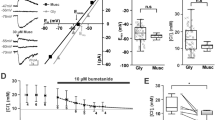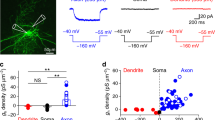Abstract
Neuronal excitability in the CNS is primarily controlled by a balance between synaptic excitation and inhibition. In the brainstem and spinal cord, synaptic excitation and inhibition are mediated by the excitatory transmitter glutamate acting on ionotropic glutamate receptor–gated cationic channels and the inhibitory transmitter glycine acting on glycine receptor (GlyR)-gated chloride channels. We found that glutamate and its analog ligands potentiated GlyR-mediated currents in both cultured spinal neurons and spinal cord slices of rats. This potentiation was not dependent on activation of any known glutamate receptor and manifested as an increase in single-channel open probability. Moreover, this glutamate potentiation was seen in HEK293 cells that transiently expressed GlyRs. Our data strongly suggest that glutamate allosterically potentiates GlyR-gated chloride channels, thereby blurring the traditional distinction between excitatory and inhibitory transmitters. Such a rapid homeostatic regulatory mechanism may be important for tuning functional balance between synaptic excitation and inhibition in the CNS.
This is a preview of subscription content, access via your institution
Access options
Subscribe to this journal
Receive 12 print issues and online access
$209.00 per year
only $17.42 per issue
Buy this article
- Purchase on Springer Link
- Instant access to full article PDF
Prices may be subject to local taxes which are calculated during checkout







Similar content being viewed by others
Change history
13 April 2011
In the version of this article initially published, the vertical scale bars in Figures 2c and 3a,c,d were labeled with incorrect units (μA). The correct units should be pA. Also, the vertical scale bar label (50 pA) was missing from Figure 7a, and the labels "burst duration" and "mean Po" in Figure 4e were reversed. The errors have been corrected in the HTML and PDF versions of the article.
References
Mody, I., De Koninck, Y., Otis, T.S. & Soltesz, I. Bridging the cleft at GABA synapses in the brain. Trends Neurosci. 17, 517–525 (1994).
Betz, H. & Laube, B. Glycine receptors: recent insights into their structural organization and functional diversity. J. Neurochem. 97, 1600–1610 (2006).
Lynch, J.W. Molecular structure and function of the glycine receptor chloride channel. Physiol. Rev. 84, 1051–1095 (2004).
Johnson, J.W. & Ascher, P. Glycine potentiates the NMDA response in cultured mouse brain neurons. Nature 325, 529–531 (1987).
Kleckner, N.W. & Dingledine, R. Requirement for glycine in activation of NMDA-receptors expressed in Xenopus oocytes. Science 241, 835–837 (1988).
Dingledine, R., Kleckner, N.W. & McBain, C.J. The glycine coagonist site of the NMDA receptor. Adv. Exp. Med. Biol. 268, 17–26 (1990).
O'Brien, R.J. et al. The development of excitatory synapses in cultured spinal neurons. J. Neurosci. 17, 7339–7350 (1997).
Keller, A.F., Coull, J.A., Chery, N., Poisbeau, P. & De Koninck, Y. Region-specific developmental specialization of GABA-glycine cosynapses in laminas I-II of the rat spinal dorsal horn. J. Neurosci. 21, 7871–7880 (2001).
Wong, E.H. et al. The anticonvulsant MK-801 is a potent N-methyl-D-aspartate antagonist. Proc. Natl. Acad. Sci. USA 83, 7104–7108 (1986).
Mayer, M.L. & Armstrong, N. Structure and function of glutamate receptor ion channels. Annu. Rev. Physiol. 66, 161–181 (2004).
Dingledine, R., Borges, K., Bowie, D. & Traynelis, S.F. The glutamate receptor ion channels. Pharmacol. Rev. 51, 7–61 (1999).
Collingridge, G.L., Isaac, J.T. & Wang, Y.T. Receptor trafficking and synaptic plasticity. Nat. Rev. Neurosci. 5, 952–962 (2004).
Conn, P.J. & Pin, J.P. Pharmacology and functions of metabotropic glutamate receptors. Annu. Rev. Pharmacol. Toxicol. 37, 205–237 (1997).
Bormann, J., Hamill, O.P. & Sakmann, B. Mechanism of anion permeation through channels gated by glycine and gamma-aminobutyric acid in mouse cultured spinal neurones. J. Physiol. (Lond.) 385, 243–286 (1987).
Twyman, R.E. & Macdonald, R.L. Kinetic properties of the glycine receptor main- and sub-conductance states of mouse spinal cord neurones in culture. J. Physiol. (Lond.) 435, 303–331 (1991).
Xu, T.L., Dong, X.P. & Wang, D.S. N-methyl-D-aspartate enhancement of the glycine response in the rat sacral dorsal commissural neurons. Eur. J. Neurosci. 12, 1647–1653 (2000).
Zhu, L., Krnjevic, K., Jiang, Z., McArdle, J.J. & Ye, J.H. Ethanol suppresses fast potentiation of glycine currents by glutamate. J. Pharmacol. Exp. Ther. 302, 1193–1200 (2002).
Fucile, S., De Saint Jan, D., de Carvalho, L.P. & Bregestovski, P. Fast potentiation of glycine receptor channels of intracellular calcium in neurons and transfected cells. Neuron 28, 571–583 (2000).
Stelzer, A. & Wong, R.K. GABAA responses in hippocampal neurons are potentiated by glutamate. Nature 337, 170–173 (1989).
Baker, D.A., Xi, Z.X., Shen, H., Swanson, C.J. & Kalivas, P.W. The origin and neuronal function of in vivo nonsynaptic glutamate. J. Neurosci. 22, 9134–9141 (2002).
Nyitrai, G., Kekesi, K.A. & Juhasz, G. Extracellular level of GABA and Glu: in vivo microdialysis-HPLC measurements. Curr. Top. Med. Chem. 6, 935–940 (2006).
Vogt, K.E. & Nicoll, R.A. Glutamate and gamma-aminobutyric acid mediate a heterosynaptic depression at mossy fiber synapses in the hippocampus. Proc. Natl. Acad. Sci. USA 96, 1118–1122 (1999).
Barbour, B. & Hausser, M. Intersynaptic diffusion of neurotransmitter. Trends Neurosci. 20, 377–384 (1997).
Stafford, M.M., Brown, M.N., Mishra, P., Stanwood, G.D. & Mathews, G.C. Glutamate spillover augments GABA synthesis and release from axodendritic synapses in rat hippocampus. Hippocampus 20, 134–144 (2009).
Windhorst, U. On the role of recurrent inhibitory feedback in motor control. Prog. Neurobiol. 49, 517–587 (1996).
Turrigiano, G. Homeostatic signaling: the positive side of negative feedback. Curr. Opin. Neurobiol. 17, 318–324 (2007).
Hartmann, K., Bruehl, C., Golovko, T. & Draguhn, A. Fast homeostatic plasticity of inhibition via activity-dependent vesicular filling. PLoS ONE 3, e2979 (2008).
Grillner, S. The motor infrastructure: from ion channels to neuronal networks. Nat. Rev. Neurosci. 4, 573–586 (2003).
Clements, J.D., Lester, R.A., Tong, G., Jahr, C.E. & Westbrook, G.L. The time course of glutamate in the synaptic cleft. Science 258, 1498–1501 (1992).
Otis, T.S., Wu, Y.C. & Trussell, L.O. Delayed clearance of transmitter and the role of glutamate transporters at synapses with multiple release sites. J. Neurosci. 16, 1634–1644 (1996).
Bergles, D.E., Diamond, J.S. & Jahr, C.E. Clearance of glutamate inside the synapse and beyond. Curr. Opin. Neurobiol. 9, 293–298 (1999).
Caraiscos, V.B. et al. Insulin increases the potency of glycine at ionotropic glycine receptors. Mol. Pharmacol. 71, 1277–1287 (2007).
Burzomato, V., Groot-Kormelink, P.J., Sivilotti, L.G. & Beato, M. Stoichiometry of recombinant heteromeric glycine receptors revealed by a pore-lining region point mutation. Receptors Channels 9, 353–361 (2003).
Chéry, N., Yu, X.H. & de Koninck, Y. Visualization of lamina I of the dorsal horn in live adult rat spinal cord slices. J. Neurosci. Methods 96, 133–142 (2000).
Qin, F., Auerbach, A. & Sachs, F. Hidden Markov modeling for single channel kinetics with filtering and correlated noise. Biophys. J. 79, 1928–1944 (2000).
Qin, F., Auerbach, A. & Sachs, F. A direct optimization approach to hidden Markov modeling for single channel kinetics. Biophys. J. 79, 1915–1927 (2000).
Colquhoun, D. & Sigworth, F. Fitting and statistical analysis of single-channel records. in Single-Channel Recording (eds. B. Sakman & E. Neher) (Plenum Press, New York, 1995).
Acknowledgements
We thank Y.P. Li for preparation and maintenance of spinal cord neuronal cultures and L. Oschipok for his excellent editorial assistance. This work was supported by the Canadian Institutes for Health Research, the Heart and Stroke Foundation of British Columbia and Yukon, and the Taiwan Department of Health Clinical Trial and Research Center of Excellence (DOH99-TD-B-111-004). J.L. was supported by postdoctoral fellowships from National Sciences and Engineering Research Council, the Michael Smith Foundation for Health Research and the British Columbia Epilepsy Society. Y.T.W. is a Howard Hughes Medical Institute International Scholar and the holder of the Heart and Stroke Foundation of British Columbia and Yukon chair in stroke research.
Author information
Authors and Affiliations
Contributions
J.L., D.C.W. and Y.T.W. designed the experiments. J.L. performed and analyzed the experiments in cultured spinal neurons and spinal cord slices. D.C.W. performed and analyzed the experiments in HEK293 cells. J.L., D.C.W. and Y.T.W. wrote the manuscript.
Corresponding author
Ethics declarations
Competing interests
The authors declare no competing financial interests.
Rights and permissions
About this article
Cite this article
Liu, J., Wu, D. & Wang, Y. Allosteric potentiation of glycine receptor chloride currents by glutamate. Nat Neurosci 13, 1225–1232 (2010). https://doi.org/10.1038/nn.2633
Received:
Accepted:
Published:
Issue Date:
DOI: https://doi.org/10.1038/nn.2633
This article is cited by
-
Glutamate and GABAA receptor crosstalk mediates homeostatic regulation of neuronal excitation in the mammalian brain
Signal Transduction and Targeted Therapy (2022)
-
Metabolic effects of cannabinoids in zebrafish (Danio rerio) embryos determined by 1H NMR metabolomics
Metabolomics (2016)
-
Kainate receptor activation induces glycine receptor endocytosis through PKC deSUMOylation
Nature Communications (2014)
-
Erratum: Corrigendum: Allosteric potentiation of glycine receptor chloride currents by glutamate
Nature Neuroscience (2011)
-
A new take on glutamate
Nature Reviews Neuroscience (2010)



